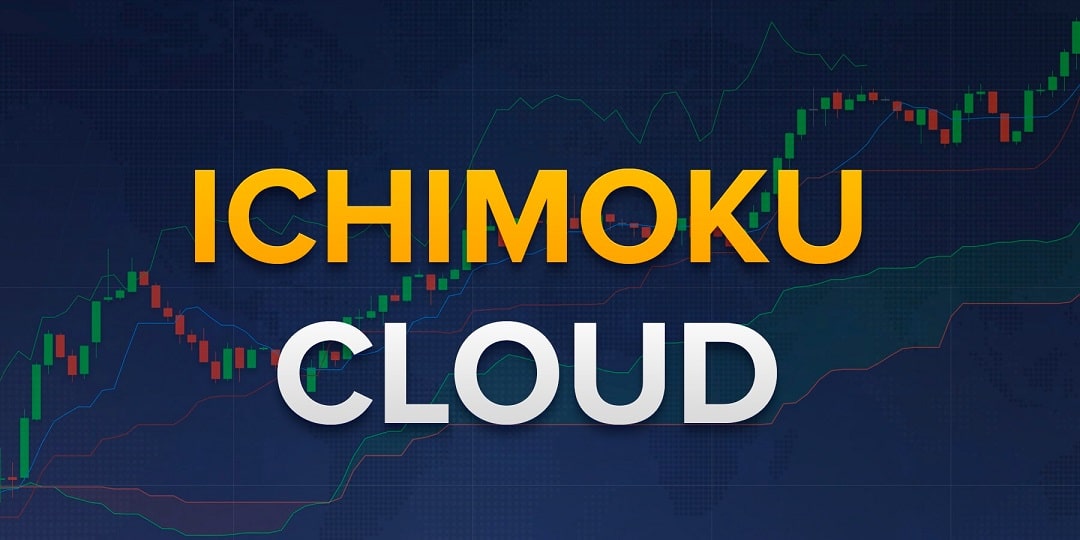Indicators are among the vital parts of the world of financial trading. Traders have been using technical tools and indicators over several decades to understand the market context, predict future movements, and make trade decisions. The Ichimoku Cloud is one of the most typical technical indicators that global investors choose.
This article will introduce you to the Ichimoku Clouds indicator. However, executing successful trades using technical tools involves understanding the indicator’s features, capabilities, functionalities, limitations, and potentialities. Let’s look at the complete guide to executing trades using chart attachments besides listing this tool’s top pros and cons.
What is the Ichimoku Cloud indicator?
The Ichimoku Kinko Hyo is a technical indicator that determines different market info at once, such as trend direction, momentum, and support resistance levels, of trading assets on any time frame chart. The developer of this indicator is a Japanese journalist, Goichi Hosoda, and the publication took place in 1969 in his book.
He defines this indicator as a “one look equilibrium chart” that generates potentially profitable trade ideas by calculating market data in various ways. You may group this indicator to a detailed list, which will be straightforward if you can master the concepts.

The parts of the Ichimoku Cloud are:
Tenkan-Sen
It is the fastest and most active line. Traders also define it as a conversion line with blue color in the built-in Ichimoku Cloud on many trading platforms. Tenkan-sen calculation formula is:
Tenkan-Sen = (9-period highest high + 9-period lowest low) / 2
Kijun-Sen
Many define this line as a baseline that follows the Tenkan-Sen line. The relationship between these two lines shares similarities with moving averages of 9-day and 26-day. The color of this line is often red; meanwhile, the Kijun-Sen calculation formula is:
Kijun-Sen= (26-period high + 26-period low) / 2
Senkou Span A
It is the average conversion of the Tanken-Sen and Kijun-Sen lines. Many define it as a Leading Span, a green line. Senkou Span A calculation formula is:
Senkou Span A = (Tenkan-Sen + Kijun Sen) / 2
Senkou Span B
Many often define this as a Leading Span B through a red line. Senkou Span B calculation formula is:
Senkou Span B = (52-Period High + 52-Period Low) / 2
Chikou Span
The Chikou Span or lagging span shows the default 26 past periods. When it crosses the price, candles on the downside signal bearish, and if it crosses above the price, candles signal bullish pressure on the asset price.
How to trade using Ichimoku Cloud?
It is a unique technical indicator that shows the market context in several ways through different calculations. You can easily make profitable entry/exit positions on any asset using this indicator as it applies to almost any financial asset such as commodities, forex pairs, stocks, etc.
You can use the Tenkan-sen and Kijun-sen crossover for making short-term trading positions. When the Tenkan-sen crosses the Kijun sen on the upside, it declares a bullish pressure on the asset price, and the exact opposite crossover expresses a bearish pressure.
The Chikou Span A is above the Chikou Span B line, and the cloud color is green means the asset price is at an uptrend. Meanwhile, the exact opposite crossover between these lines occurs during bearish price movement, and the cloud color will be red. The Chiko Span above price declares an uptrend and below the price claims a downtrend.
A short-term strategy
Here we use a multi time frame analysis to get precious trading positions. We suggest using this trading method on major currency pairs as these pairs have sufficient volatility. We recommend seeking short-term trading positions on a 15-min chart and confirming the trend direction from upper time frame charts such as H4 or D1.
Bullish trade scenario
Check the price is above the green cloud on the H4 or daily chart, then observe the 15-min chart:
- The Tenkan-sen is above the Kijun-sen.
- Chikou Span line is above price candles.
- Price candles are above the cloud (green or red).
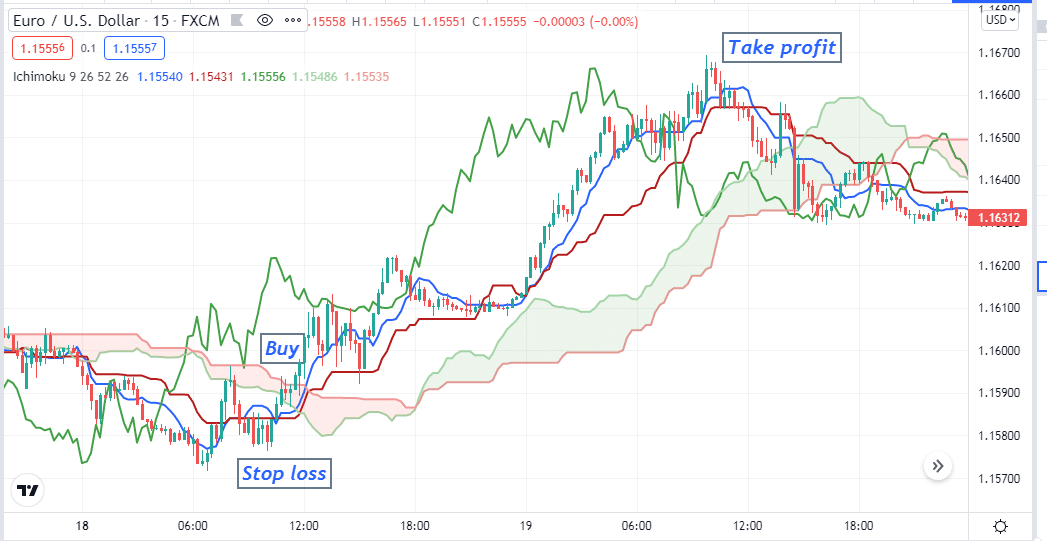
Entry
When these conditions match your target asset chart, wait until the current bullish candle formation and place a buy order.
Stop loss
The initial stop loss level will be below the current swing low with a 5-10 pips buffer.
Take profit
Your buy order is safe till the price remains above the green cloud. Close the buy order when:
- The Tanken-Sen line crosses below the Kijun-sen line.
- The Chikou Span line is crossing the price on the downside.
Bearish trade scenario
Check the price is below the red cloud on the H4, or daily chart, then observe the 15-min chart:
- The Tenkan-sen is below the Kijun-sen.
- The Chikou Span line is below price candles.
- Price candles are below the cloud (red or green).
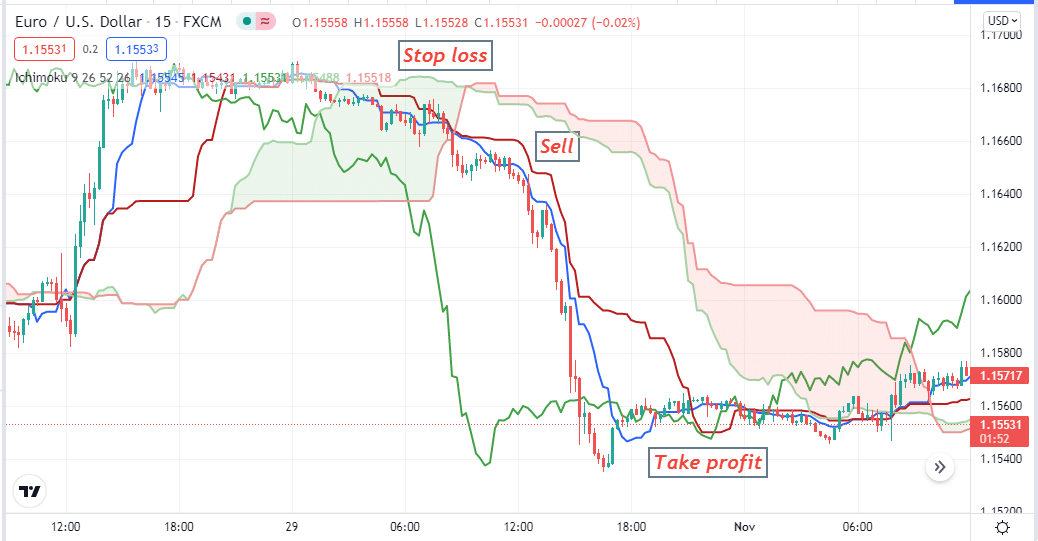
Entry
When these conditions match your target asset chart, wait until the current bearish candle formation and place a sell order.
Stop loss
The initial stop loss level will be above the current swing high with a 5-10 pips buffer.
Take profit
Your buy order is safe till the price remains below the red cloud. Close the sell order when:
- The Tanken-Sen line crosses above the Kijun-sen line.
- The Chikou Span line is crossing the price on the upside.
Pro tips
When you use this indicator, follow:
- Must check the trend direction to match your order type on the higher time frame chart.
- Avoid trading with this strategy during any major financial event of your target asset.
- Better make entry during London or New York sessions, avoid Asian sessions due to sufficient volatility.
A long-term strategy
Our long-term strategy is almost the same as the short-term strategy above. We use a D1 chart to apply this trading method.
Bullish setup
Place buy orders when all these conditions below match with your chart:
- The price crosses above the cloud.
- The cloud color turns green from red.
- Price cross above the Kijun-sen line.
- The Tanken-sen line cross above the Kijun sen-line.
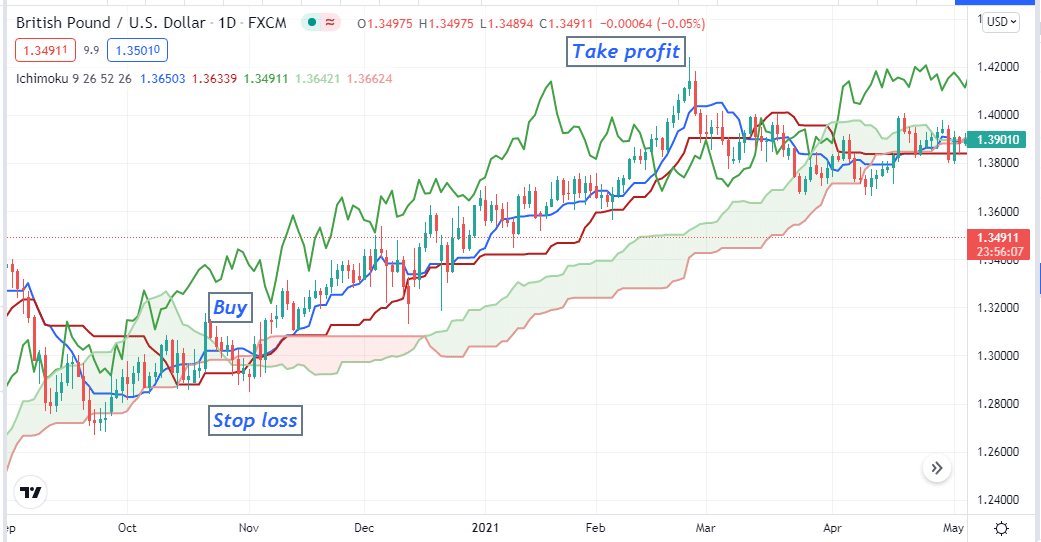
Stop loss
Put your stop loss below the current swing low.
Take profit
Close your buy order when the Chikou Span line crosses below the price.
Bearish setup
Place sell orders when all these conditions below match with your chart:
- The price crosses below the cloud.
- The cloud color turns red from green.
- Price crosses below the Kijun-sen line.
- The Tanken-sen line crosses below the Kijun sen-line.
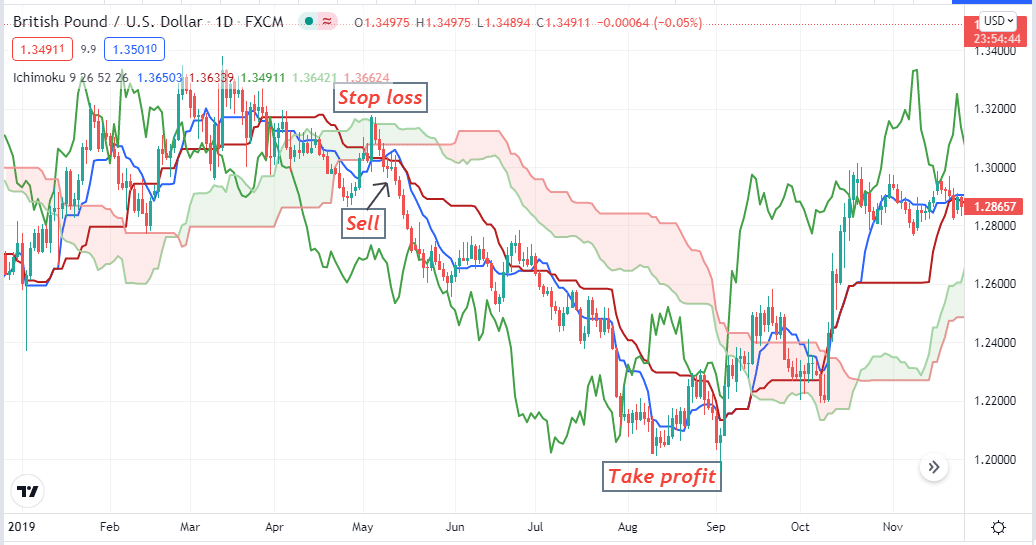
Stop loss
Put your stop loss above the current swing high.
Take profit
Close your sell order when the Chikou Span line crosses above the price.
Pros and cons of this trading tool
| Pros | Cons |
| It applies to any trading asset. | It may seem not very easy to novice traders. |
| It generates complete trade ideas with entry/exit points. | It only generates trade ideas depending on market context while ignoring fundamental factors. |
| It generates both short-term and long-term trade ideas. | It can fail in lower time frame charts during major news releases. |
Final thought
Finally, the Ichimoku Cloud is a potential indicator to trade. We suggest applying this indicator in demo trading to understand and achieve a clear concept before using it on live trading.
